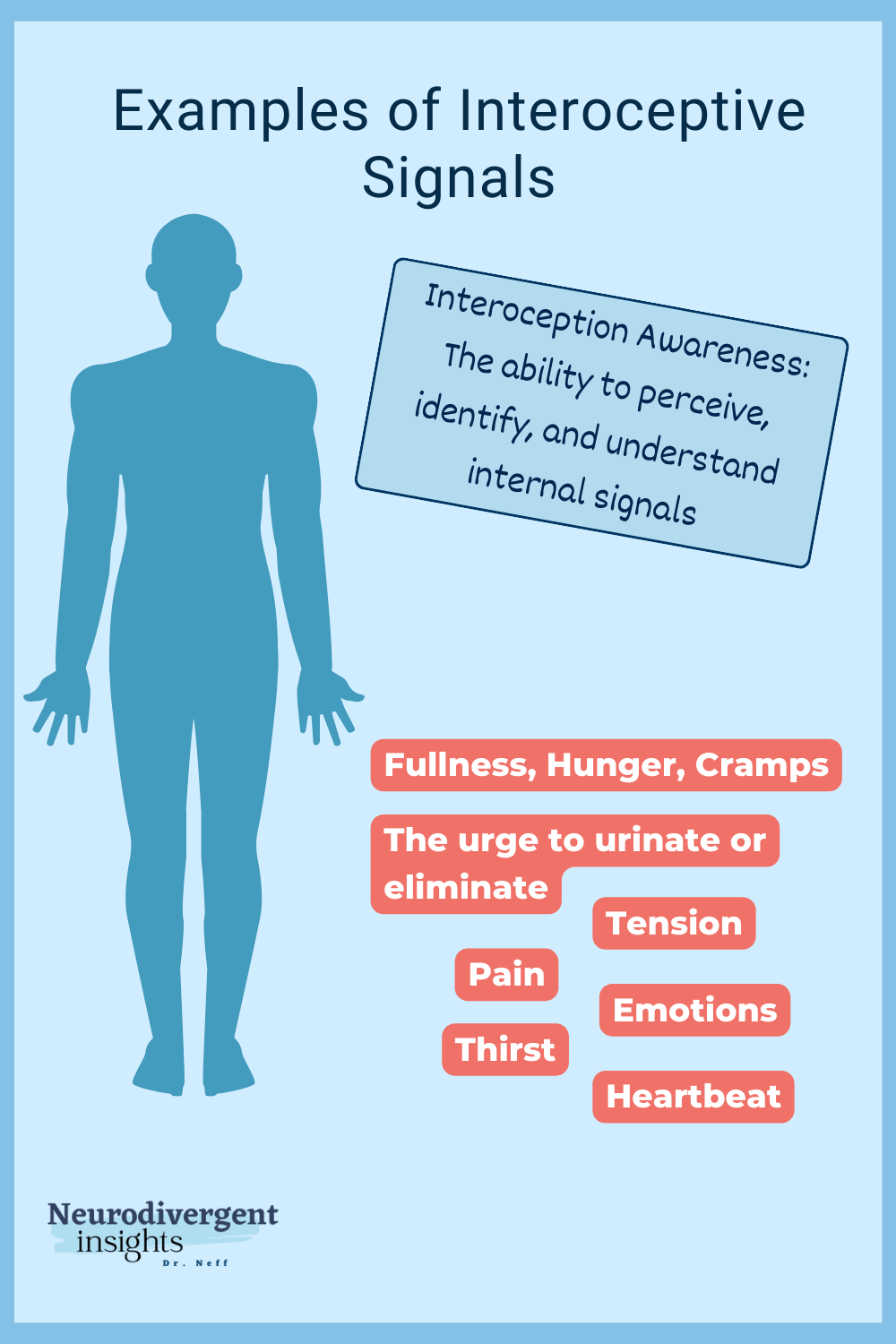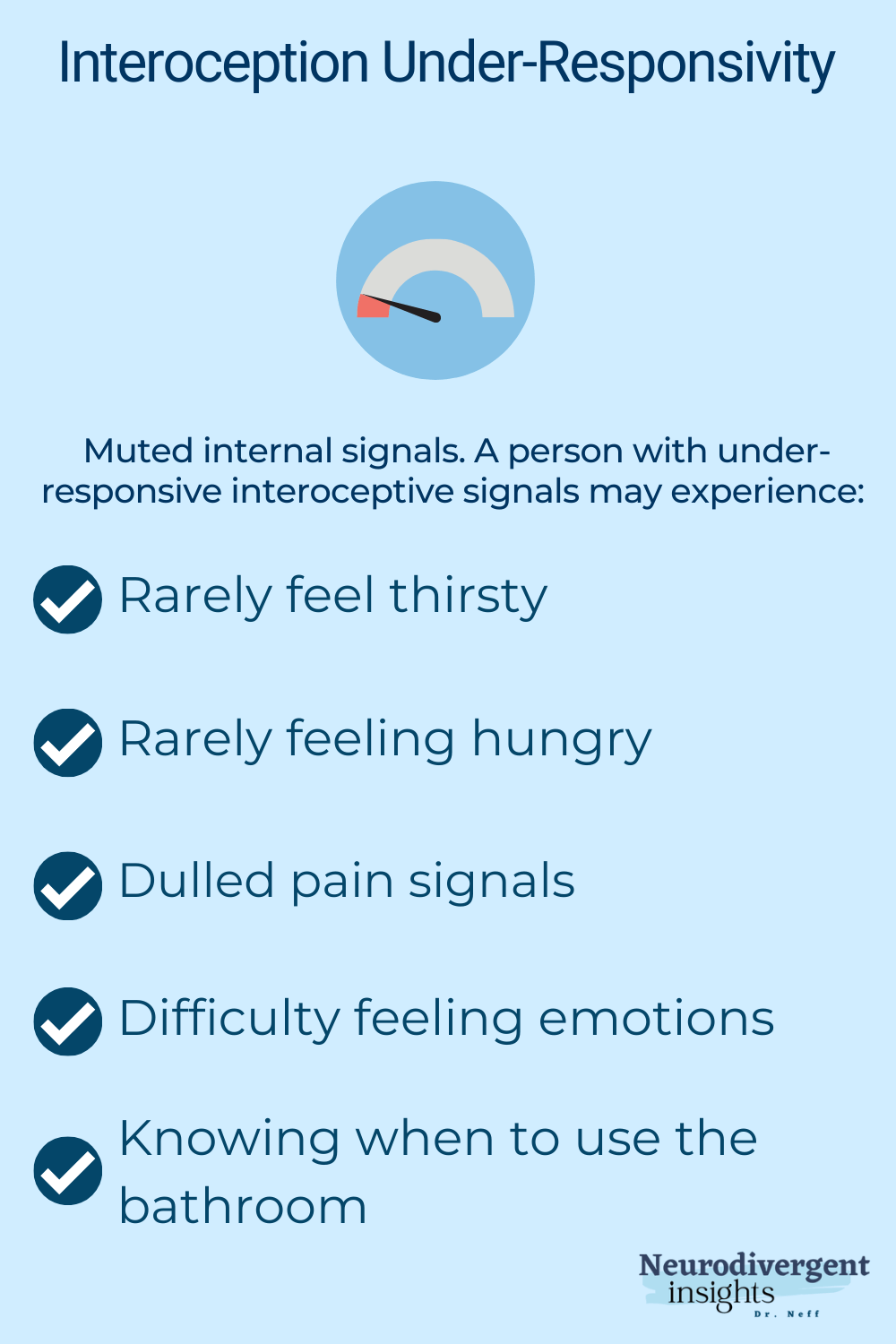Autism, ADHD, and the 3 Interoception Profiles You Need to Know
Not knowing when we’re hungry, difficulty feeling and communicating our emotions, intense feelings of pain—interoception difficulties have so many ways they can show up in us. But did you know there is more than one interoception profile you can fit into? In fact, there are three distinct ways a person may struggle with interoception awareness.
In this article, we are going to go over the interoception profiles. We’ll begin by diving into what interoception is and its relationship with neurodivergence and end by outlining the three profiles and how you can tell which you are.
Autism, ADHD, & Interoception
Before we dive into the interoception profiles, let’s first ensure we have a solid understanding of a couple of things. In this section, we will discuss what interoception is, its relationship to Autism and ADHD, and the impacts of poor interoception awareness. There’s a strong connection between neurodivergence and interoception issues. So let’s get into it.
What is Interoception?
Interoception is one of eight core sensory systems. Most of us know the basic five senses: hearing, sight, touch, taste, and smell. However, most of us overlook the last three: vestibular, proprioception, and interoception. Vestibular (sometimes called equilibrium) refers to our ability to sense gravity. Proprioception is the ability to sense where our body is in space, and interoception is the ability to understand internal states of being like hunger, pain, and stress. (Note you can learn more about these 8 sensory systems in my deep dive on the sensory systems here)
Our sense of interoception lets us know what is happening inside our body. And it allows us to maintain homeostasis (internal balance) by monitoring imbalances and motivating us to take action to fix them. For example, using sensory cells called chemoreceptors in the blood vessels, the body can detect when our blood sugar is too low. And when our blood sugar is too low, our sense of interoception makes us feel hungry, which motivates us to eat. Other things our interoception detects are thirst, temperature, discomfort, pain, whether or not we need to use the bathroom, heart rate, breathing rate, sleepfulness, wakefulness, and even emotional states like stress, fear, sadness, etc. (Note for more of a deep dive into the mechanics of interoception and impact on self-regulation you can read more about it here).
The Autism & ADHD-Interoception Relationship
Neurodivergent people often experience sensory processing differences. Most of us are aware that neurodivergent people can be sensitive to light, sound, or touch. However, these sensory processing difficulties can affect all senses, including the hidden sensory systems such as interoception. That means that we can have a hard time sensing these internal states and/or understanding what to do about them.
Until recently, the connection between interoception, Autism, and ADHD has been poorly understood. Many of the struggles Autistic and ADHD people experience are related to interoception issues; however, we have lacked the appropriate lens for understanding this until recently. Many of the symptoms associated with Autism and ADHD are actually a result of interoception problems, including alexithymia (difficulty understanding and communicating emotions), empathy differences, and difficulty taking care of ourselves.
The Impacts of Poor Interoception
The signals our bodies send us are critical to our survival. That means when someone experiences interoception problems, serious issues can arise as a result. These include issues with maintaining homeostasis, self-regulation, emotional regulation, hydration, nutrition, thermoregulation, pain, and injuries, differentiating between self and other, empathy, perspective, and other health and relationship issues. Autism and ADHD already impact all of these areas of our lives, but the interoceptive difficulties make these issues worse.
Interoception difficulties can cause a host of problems for Autistic people and ADHDers. Not only may we have trouble with hunger and eating, but also emotional regulation, sleep, feeling pain, knowing when to use the bathroom, and understanding when our bodies have unmet needs.
3 Interoception Profiles
There’s more than one way someone can experience interoceptive awareness issues. In this section, we are going to discuss the three interoception profiles: under-responsivity, over-responsivity, and discrimination difficulties (Mahler, 2017). While Under-responsivity is most commonly discussed in Autistic spaces, but there are other profiles to explore, too. It’s important to note that interoception profiles can change throughout one’s life span. For example, over-responsivity is most common in children, while under-responsivity is most common in adults. Additionally, a person may have characteristics of more than one profile.
Under-Responsivity
If somebody experiences interoceptive under-responsivity, then the person experiences muted internal signals. This could mean the sensory cells themselves are under-sensitive, or the brain could have a hard time receiving and incorporating the signals. That means the person with under-responsive interoceptive signals could:
✦ Rarely feel thirsty, leading to dehydration.
✦ Rarely feeling hungry, which could lead to skipping meals, forgetting to eat, and not eating enough of what they need. This can lead to all sorts of problems, including imbalanced blood sugar, low micronutrient levels, hormone spikes and higher levels of stress hormones, eating disorders, and more.
✦ Experience dulled pain signals, which can lead to self-injury, worsening existing injuries, and infection of overlooked wounds. It also means adults could delay seeking medical attention even if they’re really sick, or they could feel vaguely sick all of the time.
✦ Difficulty feeling their emotions until they are really big. This often leads to meltdowns, outbursts, and fear of emotions. It also means greater levels of anxiety, depression, and other mental health disorders and overall more difficulty regulating their emotions.
✦ Knowing when to use the bathroom which could result in constipation and urinary tract infections. This also means children with interoceptive under-responsivity have a hard time with toilet training.
Over-Responsivity
As you probably can imagine, over-responders are the opposite of under-responders. Those with over-responsive interoceptive signals experience all of their internal signals on high alert all the time. Internal signals that would be easy to ignore for most people are intensified in the bodies of over-responders to the point they can’t overlook them. Over-responders can:
✦ Experience unquenchable thirst, leading to overhydration and imbalanced electrolytes.
✦ Frequent hunger signals, leading to overeating, high blood sugar, imbalanced hormone levels, and more.
✦ Amplified pain signals. This can mean pain that most of us can ignore would feel serious to the over-responder, which can lead to them seeking medical attention when they don’t need it. This also means over-responders can take longer to recover from injuries and illness (this may lead to them being labeled as a “hypochondriac,” however their pain is subjectively real and intense).
✦ A heightened experience of their emotions and experience more dramatic shifts in emotions.
✦Urge to urinate, resulting in the frequent use of the bathroom, including through the night.
Discrimination Difficulties
People with interoceptive discrimination difficulties have difficulty differentiating between the signals they’re experiencing (for example, the difference between hunger signals and anxiety). For such people, the signals coming in from their body often feel like a chaotic jumble! People with discrimination difficulties could:
✦ Difficulty understanding whether they feel thirsty or if they have a sore throat. They could also feel a vague sense of thirst but are unsure of how much water they want to drink.
✦ Have trouble differentiating signals like hunger from anxiety.
✦ Feel a diffuse sense of being unwell and sick. Therefore, when asked, “in what ways are you feeling sick?” they may answer, “I don’t know.”
✦ Confusion about which emotions they’re feeling. This can lead to trouble communicating emotions or confusing different emotions with one another. For example, if they are excited, their brain may interpret that feeling as fear instead.
✦ Trouble meeting their body’s needs because they don’t know how to interpret their body’s signals. This can look like not knowing when to use the bathroom, how to take care of themselves when their sick, or knowing what clothes to wear to keep them at a comfortable temperature.
Summary: Autism, ADHD, & Interoception
There are so many ways interoception issues can express themselves in our bodies. In this article, you learned what interoception is, its relationship to Autism and ADHD, and the impacts of poor interoception. Plus, you now know about the three interoception profiles and how to identify them, including under-responsivity, over-responsivity, and discrimination difficulties. To learn more about improving interoception awareness, check out this blog post about it here or my complete interoception workbook, which covers several strategies for improving interoception awareness.
This post was proofread by Grammarly, my go-to for proofreading and catching all the details I naturally miss! Grammarly is entirely free to use. Click here to give it a try.
References
Mahler, K. (2017). Interoception. The eighth sensory system. Lenexa, KS: AAPC Publishing.








